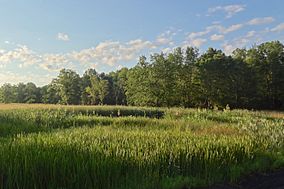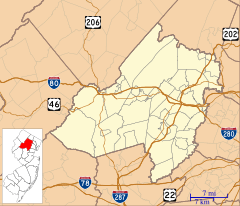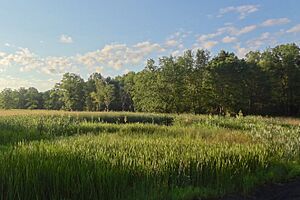Troy Meadows facts for kids
Quick facts for kids Troy Meadows |
|
|---|---|
 |
|
| Location | Morris County, New Jersey |
| Nearest city | Parsippany |
| Area | 3,100 acres (1,300 ha) |
| Designated: | 1967 |
Troy Meadows is a large nature preserve in Parsippany, Morris County, New Jersey. It covers about 3,100 acres (1,300 hectares) of land. This makes it the biggest freshwater marsh in New Jersey.
The Whippany River flows right through the swamp. It then joins the Rockaway River. Troy Meadows is an important part of the Northeastern coastal forests ecoregion. An ecoregion is a large area of land or water that has its own unique mix of natural communities and environmental conditions.
In 1967, Troy Meadows was named a National Natural Landmark. This means it's a special place that shows the best examples of natural history in the United States. It is also one of the last parts of a huge ancient lake called Glacial Lake Passaic. The Great Swamp is another part of this old lake.
Contents
How Troy Meadows Was Formed
Ancient Earth Movements
Millions of years ago, the Earth's landmasses were moving. Around 400 million years ago, a small continent crashed into what would become North America. This caused the land to fold and break apart. Later, about 350 million years ago, the African plate also pushed against North America. This created the large Appalachian Mountains.
When the African plate pulled away, it left behind a long, deep valley. This valley stretches from near Boonton, through Parsippany, and down to the Great Swamp. A major break in the Earth's crust, called the Ramapo Fault, runs through this area. This fault separates two different land regions: the Highlands and the Piedmont.
The Ice Age and Glacial Lake Passaic
Much more recently, from about 25,000 to 13,000 years ago, a giant sheet of ice covered this area. This was the Wisconsin Glacier. As the Earth warmed, the glacier began to melt. All that melting ice created a massive body of water called Glacial Lake Passaic.
Over time, this huge lake slowly drained away. As the water left, it shaped the land, leaving behind the wet, marshy area we now call Troy Meadows. This process is how this unique natural preserve came to be.
Who Owns Troy Meadows
Troy Meadows is owned by two groups. Part of the marsh belongs to a group called Wildlife Preserves. The rest is owned by the State of New Jersey. Together, they help protect this important natural area.
If you visit, you can explore part of the marsh on a two-mile-long boardwalk. This boardwalk lets you walk safely through the wetlands without disturbing the plants and animals.
Images for kids




